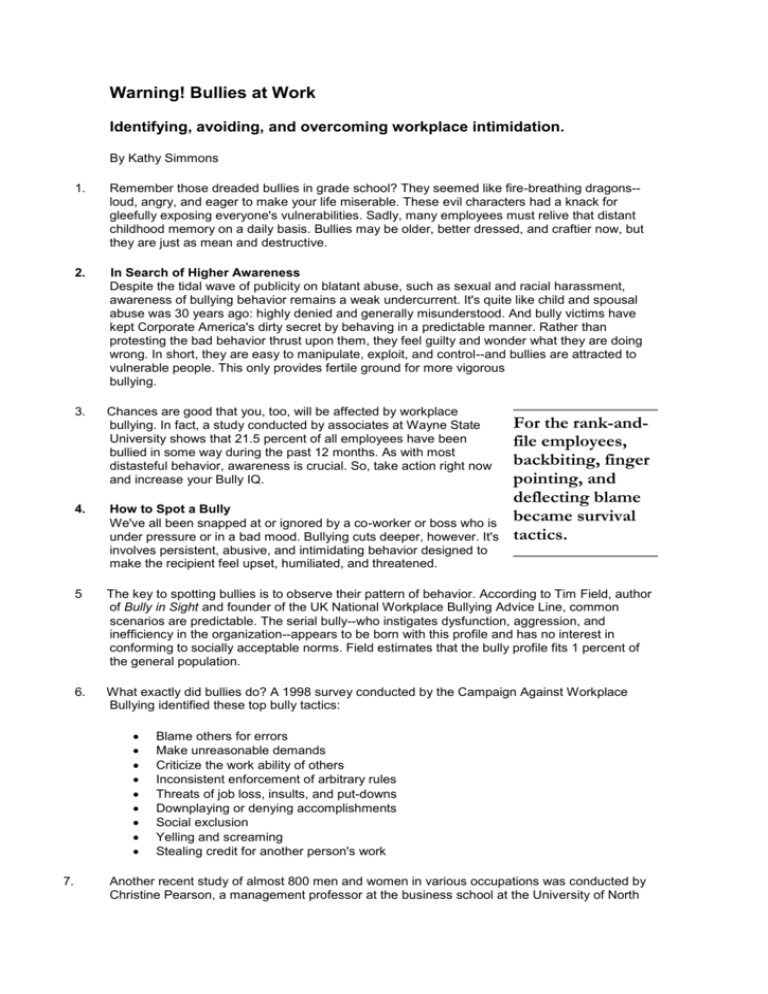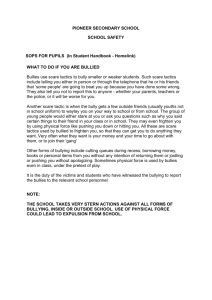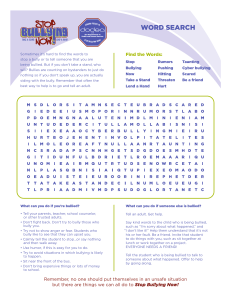Warning! Bullies at Work
advertisement

Warning! Bullies at Work Identifying, avoiding, and overcoming workplace intimidation. By Kathy Simmons 1. Remember those dreaded bullies in grade school? They seemed like fire-breathing dragons-loud, angry, and eager to make your life miserable. These evil characters had a knack for gleefully exposing everyone's vulnerabilities. Sadly, many employees must relive that distant childhood memory on a daily basis. Bullies may be older, better dressed, and craftier now, but they are just as mean and destructive. 2. In Search of Higher Awareness Despite the tidal wave of publicity on blatant abuse, such as sexual and racial harassment, awareness of bullying behavior remains a weak undercurrent. It's quite like child and spousal abuse was 30 years ago: highly denied and generally misunderstood. And bully victims have kept Corporate America's dirty secret by behaving in a predictable manner. Rather than protesting the bad behavior thrust upon them, they feel guilty and wonder what they are doing wrong. In short, they are easy to manipulate, exploit, and control--and bullies are attracted to vulnerable people. This only provides fertile ground for more vigorous bullying. 3. Chances are good that you, too, will be affected by workplace bullying. In fact, a study conducted by associates at Wayne State University shows that 21.5 percent of all employees have been bullied in some way during the past 12 months. As with most distasteful behavior, awareness is crucial. So, take action right now and increase your Bully IQ. 4. How to Spot a Bully We've all been snapped at or ignored by a co-worker or boss who is under pressure or in a bad mood. Bullying cuts deeper, however. It's involves persistent, abusive, and intimidating behavior designed to make the recipient feel upset, humiliated, and threatened. 5 The key to spotting bullies is to observe their pattern of behavior. According to Tim Field, author of Bully in Sight and founder of the UK National Workplace Bullying Advice Line, common scenarios are predictable. The serial bully--who instigates dysfunction, aggression, and inefficiency in the organization--appears to be born with this profile and has no interest in conforming to socially acceptable norms. Field estimates that the bully profile fits 1 percent of the general population. 6. What exactly did bullies do? A 1998 survey conducted by the Campaign Against Workplace Bullying identified these top bully tactics: 7. For the rank-andfile employees, backbiting, finger pointing, and deflecting blame became survival tactics. Blame others for errors Make unreasonable demands Criticize the work ability of others Inconsistent enforcement of arbitrary rules Threats of job loss, insults, and put-downs Downplaying or denying accomplishments Social exclusion Yelling and screaming Stealing credit for another person's work Another recent study of almost 800 men and women in various occupations was conducted by Christine Pearson, a management professor at the business school at the University of North Carolina at Chapel Hill. Pearson found that 70 percent of all bullies are men, but these men target women 69 percent of the time. Female bullies also target women over men by an 8-to-1 margin. Thus, it stands to reason that most bullying episodes victimize women. What's worse, 82 percent of these bullies are bosses, so they have the power to terminate their targets at will. 8. Beating Up the Bottom Line Employees aren't the only ones to feel the pain from bullying. The companies they worked for also suffer, as evidenced by Pearson's survey. She found that 52 percent of all victims spent company time worrying about their tormentor rather than working--and 28 percent of them actually missed work to avoid the person. More than one out of every five victims decreased the quality of their work. Almost 12 percent gave in and changed jobs. 9. Hard Core Bullies Tim Field has heard the horror stories. One involves a victim who was caring for a dying partner or relative. The Bully Supervisor refused to give him any time off. Eventually, the victim took personal leave under the threat of disciplinary action. The bully found out the phone number of the dying relative, made a call, and kept up the harassment. 10. Another experienced bully took delight in publicly humiliating the work of his employees. His favorite expression was "Let us know when you decide to grow a brain." He thought it was a bad day if he had not reduced at least one staff member to tears. 11 Finally, Field heard about one charming bully who used "humor" as her secret weapon, delivering cutting remarks that tormented her co-workers. Whenever they reacted with understandable distress, this bully just innocently widened her eyes and said, "Can't you take a joke? I was only kidding!" 12 Traveling in Packs Bullies enjoy partnering with other mean-spirited folks, or mobbing. "Mobbing" is a group's systematic intimidation or conscious exclusion of a targeted individual. The goal is to coerce, control, or punish another person. It's used to intimidate co-workers or even thwart the power of a supervisor or manager--which could lead to that person's dismissal. 13 According to Dr. Noa Davenport, co-author of Mobbing: Emotional Abuse in the American Workplace (Civil Society, 1999), this type of emotional abuse takes the form of "innuendo, rumors, and public discrediting." Mobbing generally "creates a malicious work environment." 14 There's generally a leader of the pack, someone who is jealous of another employee's personal and professional success. Their mobbing style takes several forms, from "forgetting" to invite a victim to meetings, taking credit for his or her work, or even physically segregating the employee from others. 15 Bully Bosses Lousy leaders routinely use fear to "motivate" employees, according to Daniel Goleman, Ph.D., author of Working With Emotional Intelligence (Bantam Doubleday, 2000). "Fear binds people to silence," says Goleman. Take the fate of whistle-blowers who publicly reveal organizational misdeeds. Rather than being thanked for their noble efforts, they are usually fired for one reason or another. This action, according to Goleman, sends a message to everyone else: "Go along with the collusion here--lest you, too, lose your membership." 16 One retired executive knows how corporate culture can reinforce bully behavior. "Our company personality took a 180-degree turn when an insecure, reactionary new boss, who believed in micromanagement, scare tactics, and public flogging, came onboard. Management became insecure about keeping their jobs if they dared express their opinions. For the rank-and-file employees, backbiting, finger pointing, and deflecting blame became survival tactics," she laments. "A forward-looking, convivial business turned into a maelstrom of anxiety for all except the emperor's favorites." 17 How do these bullies become managers? "Many have climbed the corporate ladder because they have great technical skills," says David Weiman, a Philadelphia psychologist who specializes in leadership development. But no one checks to see if they have the interpersonal skills needed to manage others. Intimidated employees are scared. They rarely complain, leaving bad supervisors undiscovered by management for a long time. Weiman advises companies to be cautious when promoting people to positions of leadership: "It's usually less expensive to develop good managers than to replace bad ones." QUESTIONS A. Choose the correct answer a, b or c 1. (Paragraph 1) When playground bullies grow up and move into the workplace, they a) become loud and angry individuals b) tend to reduce their bullying behaviour c) become even more clever and calculating 2. (Paragraph 2-3) How do bullied victims usually react? a) they complain to their manager b) they fight back c) they keep quiet 3. (Paragraph 4-7) Most workplace bullies a) are in a position of authority b) are socially popular c) are women 4. (Paragraph 8) Victims of bullying make the company suffer by a) having a negative attitude to work b) taking time off work c) spending time planning revenge 5. (Paragraph 9-11) From the examples of bullying behaviour, we can see bullies tend to a) phone the victims’ families a) have a good sense of humour b) enjoy using sarcasm B. Vocabulary. Find words or expressions which match the definitions 1. 2. 3. 4. 5. 6. 7. 8. 9. 10. (para 1) keen, enthusiastic (para 1) ability or skill (para 2) obvious, flagrant (para 4) spoken to in a short and angry way (para 6) minimising (para 11) joking, teasing (para 12) constrain, pressurize (para 12) impede, obstruct (para 13) group, gang (para 15) ties 11. (para 16) beating, chastising 12. (para 16) criticising somebody to others C. Read paragraphs 12 to 17 and answer the following questions. Use your own words as far as possible. 1. What is the difference between mobbing and bullying? 2. What are the main features of a workplace where the boss is a bully? 3. How can bullies be prevented from becoming managers? D. Have you had any personal experience of bullying or mobbing? Tell us about it. Send your answers to all of the above questions to the classroom (Activities)







